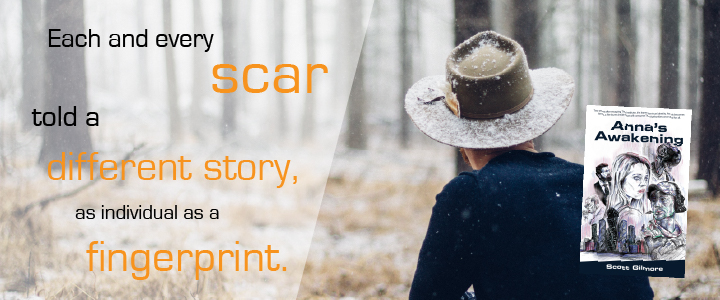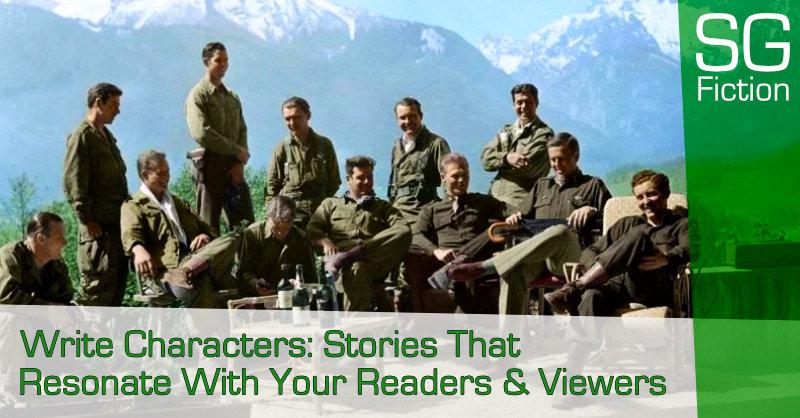Do you write characters that resonate with your readers? It’s vital to make our readers and viewers feel attached to the characters we write. By neglecting this, we neglect our position as storytellers.
In this Write Characters article, you will find advice in these areas:
- Why you should define every character in a story and spend time to ensure they are unique, meaning they will stand apart in your story,
- Why it’s important to include flaws within your character and allow them to be shown to the reader, meaning they are relatable to an audience,
- The importance of genuine peril and how it can create organic drama, allowing your readers to see how a character reacts,
- How great character examples in Band of Brothers compares to modern Star Wars, showing how modern stories have forgotten the importance of good character writing.
Read the rest of the Character Writing article to learn how you can ensure your characters have the basic building blocks to make them resonate with readers.
When we write characters, it is a lengthy process that allows us the opportunity to delve deep into the personalities of those whom we want to populate the worlds we create. Therefore, this means we owe it to the characters and our readers, to ensure that their stories are as detailed and well-rounded as possible. As creators, we need to attempt to ensure any character in a story we write resonates with our readers. Only then can we evoke an emotional response from those who have bought our books or watched our play.
I am writing this creative writing blog article in during the week of the VE Day celebrations in Britain. I have watched multiple TV programmes or news reports sharing the stories of those who gave so much for the UK and her allies during the Second World War. It was during the multiple scheduled shows and news stories that I was reminded of one of the most powerful TV series I have ever seen – Band Of Brothers.
On the evening of VE Day, I went to retrieve the Blu Ray boxset of Band of Brothers from the cabinet in the living room. I then sat down to relive the journey of Easy Company, as they prepared for and battled across WW2 Europe.
Inside the first few episodes, I was blown away by the raw tension, brutality, and emotional investment I had in these men and their journey. There were a group of characters whom I cared about, who I was worried about and, in the case of David Schwimmer‘s character, downright disliked. With this company of soldiers, I was there with them as they jumped from the planes into Nazi flak cannon fire.
I was then reminded of a ‘blockbuster’ movie that I watched with my son on May the 4th – Star Wars: The Rise Of Skywalker. I vaguely remembered Rey, Finn, and Poe as they ran around the galaxy on pointless hunts for trinkets. I am revisited by the multiple coincidental plot points that met them on their journeys and the limitless Rey as she sailed towards inevitable victory. Even Ollie, my 5-year-old son, decided to do an Avengers jigsaw puzzle until ‘the big fight’ with space horses at the end.
As a fiction author and experienced educator, we must have deep characters with stories that resonate with us. For both children and adults alike, authors need to write characters that give us a reason to laugh, cry, fret over, and experience pure elation. If writers don’t attempt to write a character in a story that challenges us and makes us feel those emotions, they neglect their position as storytellers. Here’s why.

Define Every Character In A Story
When you sit down to write characters for your upcoming novel, short story, or script, it is vital that you ensure each character is as unique as possible. By doing so, you will give them unique properties that help them to stand out amongst the other characters. This planning should go right down to areas, such as:
- Their mannerisms,
- How they interact with others,
- Ways in which the settings impress upon them, and
- How they use language in dialogue with others in the story.
There are tens of ways you can define characters to make sure they are unique and different from one another in the book or play you write. It has to be remembered that the reader or audience live the story you tell through the characters. They are the vehicle through whom the story is experienced. This means, by spending serious time developing the intricate details that make up every character in your story, you can make lasting impressions on the minds of readers.
Within Band Of Brothers, the main characters are all very well written as they are based upon real-life veterans. Still, the writers ensure the characters have varying strengths, weaknesses and have different approaches to the situations they face. To write characters like this means the audience is kept on the edge of their seats because they are unsure how events will unfold for the soldiers before them.
Writing like this ensures you experience the journey with them as they make their way through World War II Europe. The audience sees the highs, the lows, and the moments of levity that punctuate the horror of war. Before your eyes, you watch the war shape and mould them into a family who would die for one another.
As events unfold, you feel connected with the soldiers. You feel relieved when a character makes it through an artillery bombardment and devastated when you witness one of the men die. This is what happens when you feel for a character and get to know them as people rather than empty vessels. This is central to your job as a writer. You need to define each character as being unique and memorable for the reader. Only then will the reader see a realism within the characters that is worth investing time and emotional energy in.
In movies like Star Wars: The Rise Of Skywalker, there is none of this, and it is prevalent throughout the entire final Disney Star Wars trilogy. When we watch the vacuous Rey battle her way through obstacle after brittle obstacle, we don’t have the definition that better-written characters have. We know very little about her and haven’t seen her struggle against any actual obstacles throughout the previous two movies. Instead, we see a blank girl and her equally hollow friends rush through multiple meaningless events that are filled with special effects that are a feast for the eyes, but little else.
As the recent trilogy shoots through their running times, there is little time spent getting to know the characters. This means we don’t get much if any, time to learn the intricate details that make for good character writing. This means the characters are very one-dimensional and are rarely faced with obstacles that may be used to show unique inner qualities to make their spell on-screen memorable. By not allowing for proper character definition and development, the writers failed to give the majority of the audience what they wanted – a trilogy of movies that would last for decades, like the original trilogy.
When you write characters, do your utmost to set them apart from the others in your story. Allow them time to breathe and share time with the audience. Let them have some space to decide whether they are a character worth investing time and emotional energy. By doing so, you stand a better chance of writing every character in your story who are people capable of evoking an emotional response from readers or viewers. Do this, and you will do your job as a writer.

Write Characters With Flaws
When you sit down to write characters, it is important to plan their personalities for flaws and elements within that some may even define as a weakness. This is an important lesson for young writers to learn, especially. In real life, no one is perfect. This is a truth that is inescapable and one that we must accept as people, and as writers. By doing so, you will be able to put your characters through more in-depth scrutiny and ensure they are relatable to those who read your books.
To dig deep into what makes your character who they are, means you may see evidence of traits, like:
- Jealousy,
- Deceit,
- Rage, and
- Prejudice.
These traits are not pleasant, but, as people, we all possess characteristics like these. In many cases, people around us will harbour such flaws and hide them from those closest to them out of embarrassment, worry, or shame. The thought of their closest friends or family looking upon them as ‘-ists’ or ‘-phobes’ is so prevalent that such people may even attend therapy to help readjust their mindsets.
When you write a book or a screenplay, the people following the story will likely have similar flaws to the characters you write. It is vital that your characters show flaws in their personality so the audience can identify with them in some way. By seeing such weaknesses, your readers can be swayed to either like or dislike a character. With intelligent character development and considered plotting of a story, you can make the reader witness specific actions to conclude who the characters are.
This is where the old phrase ‘show, don’t tell’ comes into play. By plotting your story in a manner that allows time for characters to make mistakes, show errors of judgement, or even betrayal, your readers will witness these actions. This allows time for character development, the construction of a character arc, and for the reader to spend time with the character and draw their conclusions. This is good storytelling and excellent use of the characters you have spent so much time creating.
In Band Of Brothers, some of the individual soldiers show cowardice. They are crippled by fear when shot at or cowering in a foxhole under an artillery bombardment. These emotions are organic and realistic to how many of us would react in such situations. However, seeing such emotions is central to how we evaluate the characters before us and whether we root for them or not.
At points, some characters are filled with rage and want to execute Nazi soldiers for what may have happened to their friends in previous battles throughout the war. Again, to some viewers, this would be a rational reaction to being placed in such a situation, where one wrong decision could mean life or death.
Yet, when we see the combined unity of the company help their brothers overcome these moments of weakness, we see the humanity within them. It is through their weaknesses and fears that we witness the bond that links Easy Company, making them more potent as a unit.
Within the final Star Wars trilogy, Rey is pretty much perfect. Right from the start, she has every ability that Luke and Anakin Skywalker had to train for years to achieve. At points throughout the previous Star Wars movies, the protagonists even had to battle inner demons on their character arc. This was intriguing viewing as we begged Luke not to join the Dark Side or even for Darth Vader to fight to protect his son.
As Rey has so many natural abilities and zero inner conflict, we cannot truly identify with her. She is someone who wants to join The Resistance, so she does. She wants to be a Jedi, so she is. She has to beat Kylo Ren, so she does. It is as though she can be anything she wants simply because she wants to. Unfortunately, in life, achieving greatness comes from hard graft and overcoming multiple obstacles, and Rey doesn’t do this.
As for the other characters, they are equally as vacant and are merely there to fill up screen time. As a group, they rarely add to Rey’s character arc. Instead, they follow side-quests to find way-finders, daggers and track down hackers who don’t add anything to the story. Their roles amount to adding meaningless action to Rey’s overall romp to victory and viewers learn little about them as people. If they were fully developed as characters, they would have warranted better story arcs, and the audience may have grown to value them more.
Flaws are what make us human. As a writer, by showing that your characters are flawed, the reader can see qualities within them can be identified with. If the reader can identify with a character in your story, you stand a higher chance of eliciting a desired emotional response when the book ends.
This is what you ought to aim for as a writer. Write characters to encapsulate your audience and give them the catharsis (outpouring of emotion) that has been part of the evolution of storytelling for thousands of years. This is the reason we love stories, and it is your job as a writer to deliver such moments for your readers.

Allow Characters To Experience Peril
In life, we all face moments of stress and danger. These stresses and dangers can stretch from the mundane to the extreme and how we overcome these barriers depends on our inner qualities as people.
As we move through the Covid-19 pandemic and lockdown, there are multiple reasons why our lives have been changed. Many of the changes are in the short-term, but, for some people, adjustments will have lasting consequences, and their lives will be altered as a result.
When you write characters, they need to face stresses, dangers, and even peril to allow the reader to see how they react when in ‘hot water’. Without genuine threat, anxiety, or peril, there is no guarantee that your readers will get to witness the inner strength or character-defining moment in your story.
From the earliest days of storytelling, characters have had to:
- Face adversity,
- Make tough choices,
- Battle inner demons, and
- Overcome perilous situations.
It is through overcoming genuine barriers and obstacles that readers will see how events change your characters. A character in a story has to be changed in some way by the end. They have to learn something or grow as a person. Only by doing so will the reader feel the story may have a satisfactory conclusion.
As a science fiction author, I feel that bypassing this robs the reader of the drama and suspense. If your character doesn’t have to strive for greatness, overcome physical or inner monsters, or battle against the odds, the reader will lose the eagerness to find out what happens. The reader wants to see how your character triumphs over the perils and obstacles before them. This is the reason they buy the book in the first place, so give them what they want – drama, suspense, and peril!
In Band of Brothers, we know the outcome of the story – the fall of Nazi Germany and the Allies win the war. However, this doesn’t matter. To the viewer, it is the journey between point A and point B that matters. It is witnessing how Easy Company overcome near-impossible odds to survive the hell of WWII.
We are on the edge of our seats as we see the men witness their friends get shot, seriously wounded or even die. We feel for them and can forgive their tears as friends lose limbs, lose their minds, and get killed in the line of duty. It is this crippling fear and utter peril that pumps adrenaline through our veins and hope the characters make it through as unscathed as possible.
In the recent Star Wars trilogy, there is little peril for Rey and the other main characters. Instead, they appear to get into ‘scrapes’ with enemies and emerge unscathed. It is the older and much-loved original characters who fall by the wayside as Rey, Poe, and Finn adorn the Disney plot armour. It was these decisions taken by writers at Disney that meant audiences found it hard to accept such characters and the storylines they were given.
In the highlights of these movies, where Rey battles Kylo-Ren, there is little or no risk that she will get hurt as she faces off against a fully-trained Sith. How a girl with no experience using a light sabre can defeat an enemy such as this is laughable and unbelievable.
By the time The Rise Of Skywalker reaches its climax after Rey beats Kylo Ren multiple times, we don’t believe that she can lose a battle. She is unbeatable and without flaw. Even when Rey comes up against Emperor Palpatine in the third movie, barely anyone I spoke to expected her even to falter. It was evident that she would win and would save the day.
In such instances, there are no stakes, there is no tension, there is no peril, and there is no drama. Therefore, those who watch the movie feel little towards Rey and have little emotional investment in what happens to her because she is destined to overcome all obstacles. This is not what well-written characters and excellent storytelling does.
By not allowing genuine, organic peril to be shown in Finn, Poe, and Rey, the audience doesn’t get the chance to invest emotion in the characters. This means, if anything were to happen to one of the characters, there would be no reaction, and their demise would simply be shrugged off rather than mourned. As a good writer, you want the viewer to mourn the loss of a main character. It is the emotional response you crave at the end of the journey from writing the character to the reader finishing the book or movie.
As a writer, take care to allow characters to face genuine obstacles. Don’t give them the route to overcome it and see how their inner strengths and cunning will enable them to escape and continue their journey. If you include real obstacles that include genuine peril, your characters should be changed from the experience. They should learn, grow, and develop as people. This is where they become human, and readers can identify with them in the end.

Write Characters: The Takeaway
As a UK fiction writer, we all want to write characters that will be remembered when the credits roll or the book is closed. Whether they are held in high regard is up to the reader or audience we write for. Unfortunately, we are powerless to influence those who read our stories directly. The only way we can is to allow the reader to craft them appropriately from the start and piece together a plot that will enable them to show their strengths and how they overcome obstacles.
The mainstream world of storytelling has moved from one that was driven by writing compelling characters overcoming genuine obstacles that had high stakes, to one that is focused on spreading political messages and agenda. As a writer and a lover of stories, it is difficult to find characters whose journeys are not being influenced by popular culture or opinion in mass media and political movements.
Every character in a story you write ought to be well-defined. To spend time building them from the core out, complete with unique traits of their own, is what sets them apart from the others in the cast. When they get their time to shine, the reader will know who is speaking and will listen to their words carefully.
Write characters that are genuine and allow them to have flaws. Give them space to breathe and let your readership get to know the faults within their personalities. It is these flaws that will endear them to readers and make the characters more believable when they overcome barriers placed before them.
When comparing such an iconic TV series, like Band of Brothers, to a trilogy of ‘blockbusters’ that missed the mark, it may not be a fair fight. Yes, the final Star Wars trilogy was flawed but is it wrong of us to expect anything else in the current climate? It is unfortunate to think that such potentially good stories are continually tainted by the views of others, meaning that their legacy is polluted as a result.
With stories like Band Of Brothers, we look back at an archetypal series that was allowed to be told by real-life, ordinary people with a riveting tale of heroism and guile. Their journey is played out on the screen and compels those who watch it because they are emotionally invested in what happened to those heroes as they battled the Nazis. It is a story driven by genuine characters from the greatest generation that has ever lived as they fought real evil.
It is vital to write characters who make our readers feel. Emotion is at the core of storytelling, so make it a priority in the characters you create.


Some very good points.
Thanks again, Eileen.